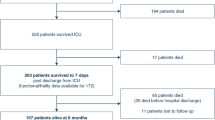The end of life in Dutch nursing homes
Background Nursing homes (NH) are less well studied than hospices or hospitals as a setting for terminal care. The aim of this study is to identify the direct causes and underlying diseases of the terminal phase in Dutch nursing homes. Methods A prospective study of terminally ill patients with a maximum life-expectancy of (less than) 6 weeks in 16 NHs in the Netherlands. 544 long-term care patients were enrolled in the study. Results The terminal phase was marked with symptoms of low fluid and food intake, general weakness and respiratory problems/dyspnea. Direct causes of these conditions were diseases of the respiratory system (mainly pneumonia), and general disorders, e.g. cachexia. Mental and behavioral disorders and diseases of the circulatory system were the two main underlying diseases of the terminal phase. Per 100 beds per year, 34 NH patients entered a terminal phase. Most patients (82.9%) died within seven days of inclusion. End-oflife decisions occurred in 70% of all deceased patients, most often made on the psycho-geriatric wards. Conclusions Providing good and timely palliative care to elderly patients in Dutch nursing homes is a major medical and societal challenge. In this study, the terminal phase of the mainly non-cancer patients is difficult to predict, and once diagnosed, little time is left.
Samenvatting
Inleiding Palliatieve zorg in verpleeg- en verzorgingshuizen is tot nog toe zeer beperkt onderzocht. Om goede palliatieve zorg in ouderenzorg te kunnen uitbouwen, is meer gericht onderzoek noodzakelijk naar patiëntkenmerken, symptoomlast, directe en onderliggende oorzaak van de terminale fase, en medische besluitvorming aan het levenseinde.
Methode Het onderzoek werd uitgevoerd in 16 verpleeghuizen, representatief voor Nederland. Alle patiënten (N=544) met een ingeschatte levensverwachting van 6 weken of minder werden geïncludeerd en gevolgd tot aan overlijden.
Resultaten De terminale fase werd gekenmerkt door een geringe inname van vocht en voeding, algemene zwakte, ademhalingsproblemen en dyspneu. De directe oorzaken daarvan waren aandoeningen van het ademhalingssysteem (vooral pneumonie), en algemene aandoeningen, incl. cachexie.
De twee belangrijkste onderliggende ziektebeelden in de terminale fase waren dementie, longziekten en CVA. Kanker kwam slechts voor bij 12% van de patiënten. Per 100 bedden/jaar, beginnen 34 verpleeghuisbewoners een terminale fase. De meeste van deze patiënten (82,9%) sterven binnen de 7 dagen nà inclusie in deze studie. Medische beslissingen aan het levenseinde kwamen frequent voor, namelijk in 70% van alle overlijdens, en het vaakst op afdelingen psychogeriatrie.
Conclusies De meeste terminale patiënten in Nederlandse verpleeghuizen zijn niet-kankerpatiënten. Hun terminale fase wordt zoals overal elders te optimistisch ingeschat, waardoor eenmaal gediagnosticeerd er nog zeer weinig tijd rest om levenseindezorg te organiseren. Palliatieve zorg in de ouderenzorg is dan ook een belangrijke medische en maatschappelijke uitdaging.
Similar content being viewed by others
Literatuur
World Health Organization. Palliative Care. The Solid Facts. Denmark: World Health Organization 2004
Zerzan J, Stearns S, Hanson L. Access to palliative care and hospice in nursing homes. JAMA 2000; 284(19):2489-94.
Happ MB, Capezuti E, Strumpf NE et al. Advance care planning and end-of-life care for hospitalized nursing home residents. J Am Geriatr Soc. 2002; 50(5):829-35.
Zimmerman S, Sloane PD, Hanson L, Mitchell CM, Shy A. Staff perceptions of end-of-life care in long-term care. J Am Med Dir Assoc. 2003; 4(1):23-6.
Froggatt KA. Palliative care and nursing homes: where next? Palliat Med. 2001; 15(1): 42-8.
Hanson LC, Henderson M, Menon M, Menon M. As individual as death itself: a focus group study of terminal care in nursing homes. J Palliat Med. 2002; 5(1): 117-25.
Brandt H. Palliative care in Dutch nursing homes. Academisch proefschrift. Vrije Universiteit Amsterdam, 2007.
Reisberg B, Ferris SH, de Leon MJ, Crook T. The Global Deterioration Scale for assessment of primary degenerative dementia. Am J Psychiatry 1982; 139(9): 1136-1139. (Dutch translation: Verhey FRJ, Maastricht 1986).
Classificatie van ziekten voor de verpleeghuisgeneeskunde. Utrecht: Stichting Informatiecentrum voor de Gezondheidszorg (SIG); 1994.
Author information
Authors and Affiliations
Corresponding author
Additional information
Afdeling Sociale Geneeskunde, EMGO Instituut, VU medisch centrum, Amsterdam; Onderzoeksgroep Zorg rond het Levenseinde, Vrije Universiteit Brussel, Brussel
NIVEL, Nederlands instituut voor onderzoek van de gezondheidszorg, Utrecht
Afdeling Verpleeghuisgeneeskunde, EMGO Instituut, VU medisch centrum, Amsterdam Correspondentie
About this article
Cite this article
Deliens, L., Brandt, H.E. & Ribbe, M.W. Het levenseinde in Nederlandse verpleeghuizen. GEEG 39, 224–232 (2008). https://doi.org/10.1007/BF03078161
Issue Date:
DOI: https://doi.org/10.1007/BF03078161




